
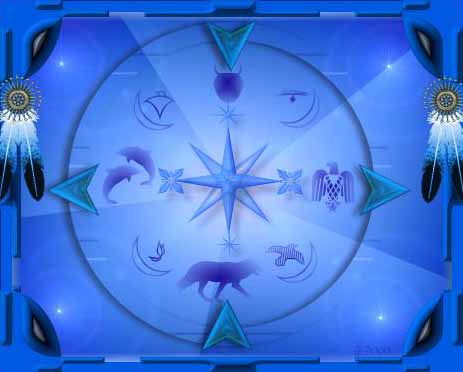


Medicine wheels, or sacred hoops, were constructed by laying stones in a particular pattern on the ground. Most medicine wheels follow the basic pattern of having a center of stone(s), and surrounding that is an outer ring of stones with "spokes", or lines of rocks radiating from the center. Some ancient types of sacred architecture were built by laying stones on the surface of the ground in particular patterns common to aboriginal peoples.
Originally, and still today, medicine wheels are stone structures constructed by certain indigenous peoples of North America for various astronomical, ritual, healing, and teaching purposes. Medicine wheels are still 'opened' or inaugurated in Native American spirituality where they are more often referred to as "sacred hoops", which is the favored English rendering by some. There are various native words to describe the ancient forms and types of rock alignments. One teaching involves the description of the four directions.
More recently, syncretic, hybridized uses of medicine wheels, magic circles, and mandala sacred technology are employed in New Age, Wiccan, Pagan and other spiritual discourse throughout the World. The rite of the sacred hoop and medicine wheel differed and differs amongst indigenous traditions, as it now does between non-indigenous peoples, and between traditional and modernist variations. The essential nature of the rite common to these divergent traditions deserves further anthropological exploration as does an exegesis of their valence.
Medicine wheels look like a wagon wheel laying on its side. Some reach diameters of 75 feet. Although archeologists aren't exactly sure what each one was used for, it is thought that they probably had ceremonial or astronomical significance.
Erecting massive stone structures is a well-documented activity of ancient man, from the Egyptian pyramids to Stonehenge, and the natives of Northern America are no different in this regard. What does separate them from the rest is how non-intrusive their structures were. Unlike the usual towering stone monoliths, the natives simply laid down lots of stones on the earth in certain arrangements. One of the more obtuse arrangements is the medicine wheel.
Medicine wheels appear all over northern United States and southern Canada, specifically South Dakota, Wyoming, Montana, Alberta, and Saskatchewan. Most of the wheels have been found in Alberta. In all over 70 medicine wheels have been found.
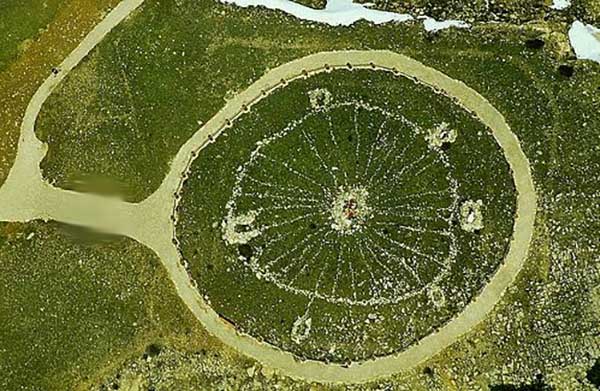
One of the prototypical medicine wheels is in Big Horn County, Wyoming. This 75 foot diameter wheel has 28 spokes, and is part of a vast set of old Native American sites that document 7,000 years of their history in that area. It is located on a ridge of Medicine Mountain, part of northern Wyoming's Big Horn Range.
It is a circular arrangement of stones measuring 75 feet across with 28 rows of stones that radiate from a central cairn to an encircling stone rim. Placed around the periphery of the wheel are five smaller, stone circles. The Medicine Wheel's function and builders remain a mystery. However, there is general agreement that it was built approximately 200 years ago by indigenous Native Americans, and that its 28 "spokes" may symbolize the days in a lunar month. To Native Americans, this remains a sacred, ceremonial site.
Medicine wheels were constructed by laying stones in a particular pattern on the ground. Most medicine wheels follow the basic pattern of having a center cairn of stones, and surrounding that would be an outer ring of stones, then there would be "spokes", or lines of rocks, coming out the cairn.
Almost all medicine wheels would have at least two of the three elements mentioned above (the center cairn, the outer ring, and the spokes), but beyond that there were many variations on this basic design, and every wheel found has been unique and has had its own style and eccentricities.
The most common deviation between different wheels are the spokes. There is no set number of spokes for a medicine wheel to have. The spokes within each wheel are rarely evenly spaced out, or even all the same length. Some medicine wheels will have one particular spoke that's significantly longer than the rest, suggesting something important about the direction it points.
Another variation is whether the spokes start from the center cairn and go out only to the outer ring, or whether they go past the outer ring, or whether they start at the outer ring and go out from there.
An odd variation sometimes found in medicine wheels is the presence of a passageway, or a doorway, in the circles. The outer ring of stones will be broken, and there will be a stone path leading up to the center of the wheel.
Also many medicine wheels have various other circles around the outside of the wheel, sometimes attached to spokes or the outer ring, and sometimes just seemingly floating free of the main structure.
Medicine wheels have been built and used for so long, and each one has enough unique characteristics, that archeologists have found it nearly impossible to tell exactly what each one was for, and haven't had much success at making broad generalizations about their function and meaning.
One of the older wheels has been dated to over 4,500 years old; it had been built up by successive generations who would add new features to the circle. Due to the long existence of such a basic structure, archeologists suspect that the function and meaning of the medicine wheel changed over time, and it is doubtful that we will ever know what the original purpose was.
It is not hard to imagine that medicine wheels, like most large stone structures, would probably have served a ceremonial or ritual purpose. There is evidence of dancing within some of the wheels. Other wheels were probably used as part of a ritual vision quest.
Astronomer John Eddy put forth the theory that some of the wheels had astronomical significance, where the longest spoke on a wheel could be pointing to a certain star at a certain time of the year, suggesting that the wheels were a way to mark certain days of the year.
Other scientists have shown that some of the wheels mark the longest day of the year. (Note that an astronomical/calendar theory has been suggested for just about every unnatural stone structure on Earth.)
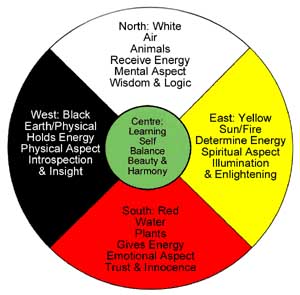
In the Hopi Medicine Wheel of the Hopi prophecy of the four peoples of the Earth, the cardinal direction North represents the body, plants and animals, the color white and 'white skinned peoples', and Childhood. (can also represent birth, and/or meeting a stranger and learning to trust as in infancy, explained in Erik Erikson's stages of Psychosocial development).
The East is held to represent the mind, air, the color yellow and 'yellow skinned peoples', learning the groups to which people belong and Adolescence.
The South holds the heart, fire, the color red and 'red skinned peoples', and Adulthood.
Finally West holds the spirit, water, the color blue or black, and 'black-skinned peoples' and Elderhood. West also represents the final life stage in the wheel, being an elder and passing on knowledge to the next generation so that the wheel may start again just like the circle it takes after.
In many other tribes, however, the Northern direction corresponds to Adulthood (the White Buffalo), the South represents Childhood (the Serpent), the West represents Adolescence (the Bear) and the Eastern direction represents Death and Re-birth (Eagle). In terms of social dynamics, community building and the use of Circles in Restorative Justice work, the four quadrants of the circle correspond to Introductions.
What is a Medicine Wheel?
Scattered across the plains of Alberta are tens of thousands of stone structures. Most of these are simple circles of cobble stones which once held down the edges of the famous tipi of the Plains Indians; these are known as "tipi rings." Others, however, were of a more esoteric nature. Extremely large stone circles - some greater than 12 metres across - may be the remains of special ceremonial dance structures. A few cobble arrangements form the outlines of human figures, most of them obviously male. Perhaps the most intriguing cobble constructions, however, are the ones known as medicine wheels.
The term "medicine wheel" was first applied to the Big Horn Medicine Wheel in Wyoming, the most southern one known. That site consists of a central cairn or rock pile surrounded by a circle of stone; lines of cobbles link the central cairn and the surrounding circle. The whole structure looks rather like a wagon wheel lain-out on the ground with the central cairn forming the hub, the radiating cobble lines the spokes, and the surrounding circle the rim. The "medicine" part of the name implies that it was of religious significance to Native peoples.
John Brumley, an archaeologist from Medicine Hat, has provided a very exacting definition of what constitutes a medicine wheel. He notes that a medicine wheel consists of at least two of the following three traits: (1) a central stone cairn, (2) one or more concentric stone circles, and/or (3) two or more stone lines radiating outward from a central point. Using this definition, there are a total of 46 medicine wheels in Alberta. This constitutes about 66% of all medicine wheels known. Alberta, it seems, is the core area for medicine wheels.
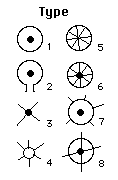
Virtually each medicine wheel has a unique form. However, we can group them into eight categories or "Types" based of their general shape. The most common form consists of a central cairn surrounded by a stone circle; 18 of these Type 1 medicine wheels are known in Alberta. A variant, known as a Type 2 medicine wheel, contains a passageway leading out from the stone circle; four are known. Type 3 structures consist of a central cairn with radiating cobble lines or "spokes;" again, four are known. Type 4 medicine wheels consist of a stone circle from which spokes radiate outward. These are the second most common form and 14 have been recorded in Alberta. Type 5 structures contain a circle with spokes radiating inward, while the Type 6 is similar but has a central cairn; only one of each occurs in the province. Type 7 medicine wheels have a central cairn surrounded by a stone circle with spokes radiating outward; three are known. Type 8 structures are similar, but the spokes radiate from the central cairn and cross the circle. Three of the former and one of the latter have been discovered in the province.
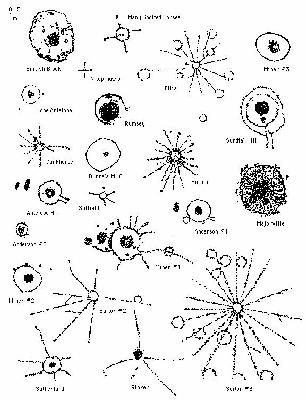
The type groupings are, of course, only a convenience for analysis. As was noted earlier, each medicine wheel is unique. Here is a sample of maps of Alberta medicine wheels reduced to more-or-less a common scale. The reader may find some amusement trying to decide which type each is.
At least one of the categories, Type 4, appears to be a correct classification. This type consists of a central circle from which spokes radiate outward. The central circle appears to be a common domestic tipi ring. The radiating spokes appear to have no consistent pattern in terms of orientation or length. Amazingly, some Type 4 medicine wheels have been built in this century by the Blood Indians of southern Alberta; one, Many Spotted Horses Medicine Wheel, is illustrated here. These modern Blood Indian structures were built to commemorate the death place of, or the last tipi occupied by, a famous warrior. The spokes are said to have no specific meaning other than to indicate that a famous warrior had died. Of course, the community is well aware of who deserves such a memorial. It appears almost certain that the prehistoric examples served the same purpose.
The purpose of all of the other types of medicine wheel are not known by archaeologists. One, Majorville Medicine Wheel, was partly excavated in 1971. This wheel contains an enormous central cairn 9 metres in diameter, surrounded by a stone circle 27 metre across; about 28 spokes link the circle and central cairn.
The excavation yielded artifacts which archaeologists can "date" by style; the style of spear points and arrowheads changed in a regular manner over time and archaeologists have figured out the sequence of these changes. It seems that the central cairn at the Majorville wheel was initially constructed some 4,500 years ago! Radiocarbon dating of bone from the bottom of the cairn confirmed this date.
It seems that successive groups of people added new layers of rock, and some of their arrowheads, from that time until the coming of Europeans to Alberta. Curiously, the site does not seem to have been used between about 3,000 and 2,000 years ago; the distinctive barbed spear points of that time are not present in the cairn. Archaeologists do not know when the spokes and surrounding circle were constructed, or even if they were constructed at the same time.
The long period of use and construction of the central cairn at the Majorville Medicine Wheel suggests that such sites may have served different functions over the years. That is, the rituals and ceremonies conducted at the site may have changed over time. It is not unusual for human beings to regard particular places as sacred, even when religions change. For example, many modern Catholic churches in Mexico occupy locales which formerly contained Aztec Indian temples.
Thus, while we can reasonably surmise that the Majorville wheel served as a ceremonial centre for several thousand years, it is unlikely that archaeologists will ever know the details of the ceremonies or the religious philosophy which motivated the construction of the site. One suspects that hunting magic or buffalo fertility might have played a part in the rituals, but the deeper meaning of the site is lost in time.
Perhaps one of the most interesting theories to be advanced is that there are significant stellar alignments present at the medicine wheels. This theory was proposed by astronomer John Eddy. He suggested that a line drawn between the central cairn and an outlying cairn at the Bighorn Medicine Wheel pointed to within 1/3 of a degree of the rising point of the sun at the summer solstice. Other alignments, both to the summer solstice sunrise and to certain bright stars such as Aldebaran, Rigel or Sirius, have been proposed for a number of Alberta medicine wheels. The wheels would thus have functioned as a calender to mark the longest day of the year. Presumably, such a calendar would be used for the timing of important rituals.
It is very difficult to confirm the astronomical hypothesis, and it is no longer as popular as it was a decade ago. A number of astronomers such as Steven Haak in Nebraska and David Vogt in Vancouver have critically evaluated the idea and have expressed severe reservations about the hypothesis. They note that simple familiarity with the night sky would likely produce an adequate estimate for timing ceremonies. Further, if great accuracy had been desired, it could have been attained better by using narrow poles as foresight and backsight than by using wider rock cairns.
Alberta's medicine wheels thus remain an enigma. Research has suggested a number of functions for the wheels, and has indicated their use over a very long period of time. Medicine wheels seem to be primarily an Alberta phenomenon; we have many more here than do the adjacent provinces and states. Investigation and preservation of these unique features has been an on-going concern of the Archaeological Survey, The Provincial Museum of Alberta, and the Planning and Resource Management Branch, Historic Sites and Archives Service.
There are 10 places in the world called "nuclei of continents". These are widely separated places of relatively small patches of ancient rocks, first cooled to the molten earth's crust 2-3 billion years old. Overlying younger rock has worn away.
These are thought to be the relatively small nuclei first cooled and built up that grew by volcanic activity and sediment accretion into a single huge island (called Gondwanaland) that began to break up in the Carboniferous era (300,000,000 years ago).
They separated, drifting on continental plates of ancient rockbed, into our present continents sometime between 65,000,000 and about 1,000,000 years ago (the continental plates continue to drift).
Medicine Mountain is one of these rare ancient continental roots. The cutaway profile shows layers of rock color-coded by age, the youngest lying in the valleys where the Bighorn and Powder Rivers run, and the oldest peaking against the sky, ancient roots down into deepest earth.
The Medicine Wheel looks from the shoulder of the most ancient times down surrounding precipices (that give it nearly a 360¡ horizon view) to slopes that get progressively more "modern" until in the valleys on either side are sedimentary rocks deposited in merely the last million to few hundred thousand years. Along the range's spine, this character of most ancient age exposed to the sky is not maintained very far north or south of the Wheel, although the physical appearance of the mountains is the same. Thus the Medicine Wheel floats on a high island of time, the world's oldest rocks, layered in reverse order of the epochs of geological history.
The other continental roots are in Yellow Knife province and a place on the Canadian Shield north of Lake Superior; the Guyana Highland in South America; the Dnieper Plateau in central Europe; Dharwar province in southern India; Guinea, Tanganyika and Rhodesian highlands in Africa; and Southwestern Australia. In none of these other continental root nuclei is there a neat folding-and-wearing of the rock layers in an ordered set peaking by age, such as is found in the Bighorns. Medicine Mountain is a very special place, where the whole geological history of the earth is layered, with the most ancient rocks of all on the peaks, layered through time downhill to the modern valleys where people live. Perhaps this was felt somehow by those who built the Wheel there many centuries ago.
- Star Knowledge Website
There are some who suggest that the spoke-like structure resembles the "Sun Dance Lodge" or "Medicine Lodge". The Sun Dance Ceremony is a celebration which is part of the fabric of Native American culture and religion.
A contemporary Cheyenne cultural leader stated, "the tribes traditionally went and still do go to the sacred mountain. The people sought the high mountain for prayer. They sought spiritual harmony with the powerful spirits there. Many offerings have been left on this mountain. The center cairn, once occupied by a large buffalo skull, was a place to make prayer offerings. Vision questors would have offered prayers for thanks for plant and animal life that had, and would, sustain them in the future. Prayers of thanks were offered for all of creation. Prayers are made for families and loved ones who are ill. Atonements are made for any offense to Mother Earth. When asking for guidance, prayers for wisdom and strength are always part of this ritual. All of this is done so that spiritual harmony will be our constant companion throughout the year.
A Crow Chief stated that Medicine Wheel was built "before the light came". Other Crow stories say the Sun God dropped it from the sky. And still others say it was built by the "Sheepeaters," a Shoshone band whose name is derived from their expertise at hunting mountain sheep. Many Crow feel it is a guide for building tipis. Some explain the wheel was built by "people without iron."
One Crow story speaks of a man named Scarface. He was handsome and was fond of strutting in his finery before young women. One day while entering his mother's tipi, he fell into the fire which severely burned his face and was thereafter embarrassed to be seen. Shamed at his appearance, he left his people and went to live in the mountains. Scarface lived alone for many years.
One day while a young woman and her grandmother were hunting berries, they became separated from their people and couldn't find their way back. They traveled along a trail which took them into the mountains. They occasionally saw Scarface and one day made contact with him. Scarface later married the young woman. On their travels back to his people, Scarface supposedly built the Medicine Wheel as their shelter. On the second day he built another tipi by the Big Horn river in the valley below. The tipi rings are believed to still exist.
It is also said that Red Plume, a great Crow Chief during the time of Lewis and Clark, found great spiritual medicine at the Medicine Wheel. The legend states that following four days without food of water, Red Plume was visited by little people who inhabited the passage to the wheel. They took him into the earth where they lived and told him that the red eagle feathers was his powerful medicine guide and protector. He was told to always wear the small feather from the back of the eagle above his tail feathers. Thus Red Plume received his name. Upon his deathbed, he told his people his spirit would be found at the wheel and that they might communicate with him there.

Big Horn Medicine Wheel